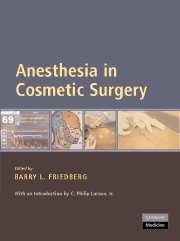Book contents
- Frontmatter
- Contents
- Foreword
- Acknowledgments
- Introduction
- Preface
- List of Contributors
- PART I MINIMALLY INVASIVE ANESTHESIA (MIA)Ⓡ FOR MINIMALLY INVASIVE SURGERY
- 1 Propofol Ketamine with Bispectral Index (BIS) Monitoring
- 2 Preoperative Instructions and Intraoperative Environment
- 3 Level-of-Consciousness Monitoring
- 4 The Dissociative Effect and Preemptive Analgesia
- 5 Special Needs of Cosmetic Dental Patients
- 6 Propofol Ketamine in the UK, Propofol Ketamine Beyond Cosmetic Surgery
- 7 Propofol Ketamine Beyond Cosmetic Surgery: Implications for Military Medicine and Mass-Casualty Anesthesia
- 8 Lidocaine Use and Toxicity in Cosmetic Surgery
- 9 Local Anesthetic Blocks in Head and Neck Surgery
- 10 Local Anesthetics and Surgical Considerations for Body Contouring
- PART II ALTERNATIVE ANESTHESIA APPROACHES IN COSMETIC SURGERY
- PART III OTHER CONSIDERATIONS FOR ANESTHESIA IN COSMETIC SURGERY
- APPENDIX A A Guide to Perioperative Nutrition
- APPENDIX B Reflections on Thirty Years as an Expert Witness
- Index
- References
4 - The Dissociative Effect and Preemptive Analgesia
from PART I - MINIMALLY INVASIVE ANESTHESIA (MIA)Ⓡ FOR MINIMALLY INVASIVE SURGERY
Published online by Cambridge University Press: 22 August 2009
- Frontmatter
- Contents
- Foreword
- Acknowledgments
- Introduction
- Preface
- List of Contributors
- PART I MINIMALLY INVASIVE ANESTHESIA (MIA)Ⓡ FOR MINIMALLY INVASIVE SURGERY
- 1 Propofol Ketamine with Bispectral Index (BIS) Monitoring
- 2 Preoperative Instructions and Intraoperative Environment
- 3 Level-of-Consciousness Monitoring
- 4 The Dissociative Effect and Preemptive Analgesia
- 5 Special Needs of Cosmetic Dental Patients
- 6 Propofol Ketamine in the UK, Propofol Ketamine Beyond Cosmetic Surgery
- 7 Propofol Ketamine Beyond Cosmetic Surgery: Implications for Military Medicine and Mass-Casualty Anesthesia
- 8 Lidocaine Use and Toxicity in Cosmetic Surgery
- 9 Local Anesthetic Blocks in Head and Neck Surgery
- 10 Local Anesthetics and Surgical Considerations for Body Contouring
- PART II ALTERNATIVE ANESTHESIA APPROACHES IN COSMETIC SURGERY
- PART III OTHER CONSIDERATIONS FOR ANESTHESIA IN COSMETIC SURGERY
- APPENDIX A A Guide to Perioperative Nutrition
- APPENDIX B Reflections on Thirty Years as an Expert Witness
- Index
- References
Summary
INTRODUCTION
A Medline search for the number of articles that contain “ketamine” yielded 8,553, with 6,905 in English. A Melvyl (University of California system catalog) search for the number of books containing “ketamine” as a word in the title or keyword yielded thirty two, with twenty in English (many are dissertations). A “Google” search for “ketamine” yielded over 250,000 sites. As reported on the World Wide Web, a 50 mg dose of ketamine (route of administration unclear) taken by itself produces an “NDE” or “near death experience,” whereas a 100 mg dose of ketamine produces an “out of body” experience. In the world of the street drug user, ketamine is a recreational drug with the reputation of unpredictable, nasty side effects. Uncontrolled “street” experimentation produced a “solution” for the nasty side effects commonly referred to as “kitty flipping.” “Kitty flipping” is the ingestion of methylenedioxymethamphetamine (MDMA), or “Ecstasy,” to produce a positive state of mind before “flipping” to “kitty,” a code name for the “k” word ketamine. MDMA is not to be confused with NMDA, N-methyl D-aspartate, the receptors blocked by ketamine.
For all that has been written about the drug ketamine, the reader could assume that much is understood. Despite the prodigious output of articles, books, and web sites, ketamine remains maligned, feared, and misunderstood as an anesthetic agent.
Ketamine was originally introduced to the anesthesia profession as a complete, total intravenous anesthetic agent.
- Type
- Chapter
- Information
- Anesthesia in Cosmetic Surgery , pp. 39 - 46Publisher: Cambridge University PressPrint publication year: 2007
References
- 2
- Cited by



